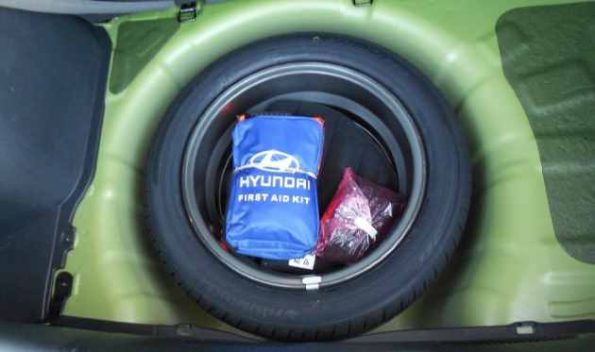Spare tyres used to be full sized but now many car manufacturers supply a narrow space saver wheel in the boot. There are good reasons for this:
- it gives you more cargo space
- they weigh less therefore give better fuel economy
- they are cheaper to produce because they are on a steel rim rather than an alloy wheel, and they don’t have to be the kind of expensive performance rubber that comes with some vehicles
- it makes it simple for the manufacturer to provide a standardised wheel when alloy wheels of different types and sizes could be chosen by the customer
- some large alloy wheels simply can’t fit into this space
- it’s safer in a rear-end collision because it’s a smaller non-deformable object, rather than having a big wheel
- it reduces the opportunities for thieves to break into the boot to steal an expensive wheel/tyre combination.
Getting a puncture isn’t as common as it was thirty years ago as tyre technology has improved, so there is less chance that you will need to use the space saver tyre. But are they safe?
Driving safely on a space saver spare tyre

Lift up the carpet in the boot and a tiny wheel like this might be what you see.
The maximum allowable speed with a space saver fitted is 80kph.
They are only intended to be used in emergency situations where you have a flat tyre and you need to get it to a tyre shop for a replacement. The lower speed limit is imposed for two reasons:
- The space saver tyre is not designed as a high performance tyre
- Handling and braking is compromised when a space saver is fitted.
Some space saver wheels are rated with higher speeds, but the limit is still 80kph. 80kph is the dry weather speed; if it’s wet, you must drive more slowly because space saver wheels are narrow and therefore have much less grip for braking and cornering.
Space savers are designed to last around 50-100km before they wear out. You might get 300-500km out of one if you drive very carefully and on smoother roads, but this is not advisable.
Never fit more than one space saver to a car at any one time. Each space saver wheel reduces your braking and cornering performance, making it more difficult for you to avoid accidents.
Space saver tyres are safe to drive on as long as you keep your speed down, increase your following distance and you get it changed to a regular tyre as soon as possible.
The inconvenience of space saver wheels and temporary use spare tyres
A big problem with space saver wheels is that if you have to fit one, where do you then put the flat tyre you’ve removed? In some sports cars, the boot isn’t big enough, and if you’re carrying luggage you might not have room. Plus, the tyre and rim will be covered in brake dust and other dirt.
The space saver must be changed quickly which might be difficult if you are in the middle of rural Australia where a tyre shop could be 300km away, and with the lower speed it delays your journey. It’s recommended if you do live way out in the outback that you carry a proper spare wheel, not a space saver.
Remember to check the pressure in your space saver wheel when you check your car tyres’ pressure. It is likely to be different to your other tyres and this will be marked either on the side of the tyre or on the metal plate showing all tyre pressures on the B pillar (open the front door to see this).
Replacing your flat tyre
If you have a slow puncture you might be able to make it to a source of air before it gets too flat, fill it up and make it a bit further again. However, this is risky because tyres can often be cheaply repaired if they just have a nail through them, but driving on it could damage it beyond repair.
If your tyre goes instantly flat, pull over as soon as it’s safe so that you avoid damaging the rim.
If you have performance tyres or tyres with an unusual size, it’s best to call ahead to a number of tyre shops to see whether they’ve got something in stock, or how long it will take to get a tyre in.
